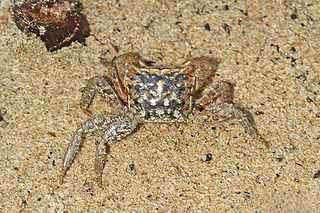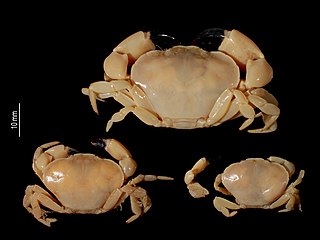
Crabs are decapod crustaceans of the infraorder Brachyura, which typically have a very short projecting tail-like abdomen, usually hidden entirely under the thorax. They live in all the world's oceans, in freshwater, and on land. They are generally covered with a thick exoskeleton. They generally have five pairs of legs, and they have pincer claws on the ends of the frontmost pair. They first appeared during the Jurassic period, around 200 million years ago.

The Thomisidae are a family of spiders, including about 170 genera and over 2,100 species. The common name crab spider is often linked to species in this family, but is also applied loosely to many other families of spiders. Many members of this family are also known as flower spiders or flower crab spiders.

Hermit crabs are anomuran decapod crustaceans of the superfamily Paguroidea that have adapted to occupy empty scavenged mollusc shells to protect their fragile exoskeletons. There are over 800 species of hermit crab, most of which possess an asymmetric abdomen concealed by a snug-fitting shell. Hermit crabs' soft (non-calcified) abdominal exoskeleton means they must occupy shelter produced by other organisms or risk being defenseless.

The Japanese spider crab is a species of marine crab and is the biggest one that lives in the waters around Japan. At around 3.7 meters, it has the largest leg-span of any arthropod. The Japanese name for this species is taka-ashi-gani,, literally translating to “tall legs crab”. It goes through three main larval stages along with a prezoeal stage to grow to its great size.

Xanthidae is a family of crabs known as gorilla crabs, mud crabs, pebble crabs or rubble crabs. Xanthid crabs are often brightly coloured and are highly poisonous, containing toxins which are not destroyed by cooking and for which no antidote is known. The toxins are similar to the tetrodotoxin and saxitoxin produced by puffer fish, and may be produced by bacteria in the genus Vibrio living in symbiosis with the crabs, mostly V. alginolyticus and V. parahaemolyticus.

The southern hairy-nosed wombat is one of three extant species of wombats. It is found in scattered areas of semiarid scrub and mallee from the eastern Nullarbor Plain to the New South Wales border area. It is the smallest of all three wombat species. The young often do not survive dry seasons. It is the state animal of South Australia.

Bison latifrons, also known as the giant bison or long-horned bison, is an extinct species of bison that lived in North America during the Late Pleistocene epoch ranging from southern Canada to Mexico. It is noted for large body size and its distinctive long horns.

Dormitator latifrons, the Pacific fat sleeper, is a species of fish in the family Eleotridae found on the Pacific coast of the Americas from around Palos Verdes, California, to Peru, where it can be found in stagnant or sluggish fresh or brackish waters or nearby marine waters. Males of this species can reach a length of 41 cm (16 in), while females grow to 39 cm (15 in). Most do not exceed 25 cm (9.8 in). A maximum weight of 1.2 kg (2.6 lb) has been recorded. This species is important to local commercial fisheries and is actively farmed.

Crab fisheries are fisheries which capture or farm crabs. True crabs make up 20% of all crustaceans caught and farmed worldwide, with about 1.4 million tonnes being consumed annually. The horse crab, Portunus trituberculatus, accounts for one quarter of that total. Other important species include flower crabs, snow crabs (Chionoecetes), blue crabs, edible or brown crabs, Dungeness crab, and mud crabs, each of which provides more than 20,000 tonnes annually.

Metopograpsus is a genus of crabs, containing the following extant species:
Kingsleya is a genus of crabs in the family Pseudothelphusidae, containing the following species:

Euryxanthops is a genus of crabs in the family Xanthidae. It was originally established in 1983 by Garth & Kim to contain three species of deep-water crabs from Japan and the Philippines - Euryxanthops dorsiconvexus, Euryxanthops flexidentatus and Euryxanthops orientalis. Since then, several more species of this genus have been identified and described, and Euryxanthops currently contains:
Neolioxantho is a genus of crabs in the family Xanthidae, containing the following species:

Xanthias is a genus of crabs in the family Xanthidae, containing two exclusively fossil species and the following extant species:

Euryxanthops cepros is a species of crab found in the Indian Ocean around Christmas Island.
Euryxanthops orientalis is a species of crab found in Sagami Bay, Japan.
Euryxanthops chiltoni is a species of crab found in the New Zealand Exclusive Economic Zone. It was first described by Colin McLay and Peter Ng in a 2007 paper, along with Medaeops serenei.
Euryxanthops dorsiconvexus is a species of crab.
Euryxanthops flexidentatus is a species of crab.

Tasmanoplax latifrons, commonly known as the southern sentinel crab, is a species of crab found on the south-east coast of Australia, from Tasmania to southern NSW, as far north as the Hunter river. It inhabits tidal mudflats with seagrass, and forms burrows. It is the only species in the genus Tasmanoplax.














